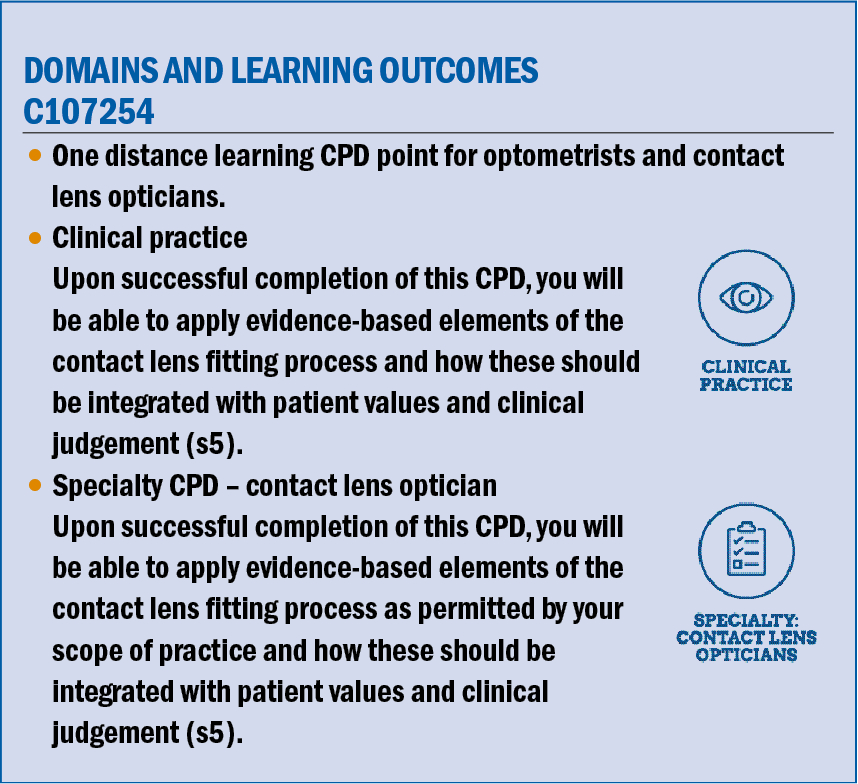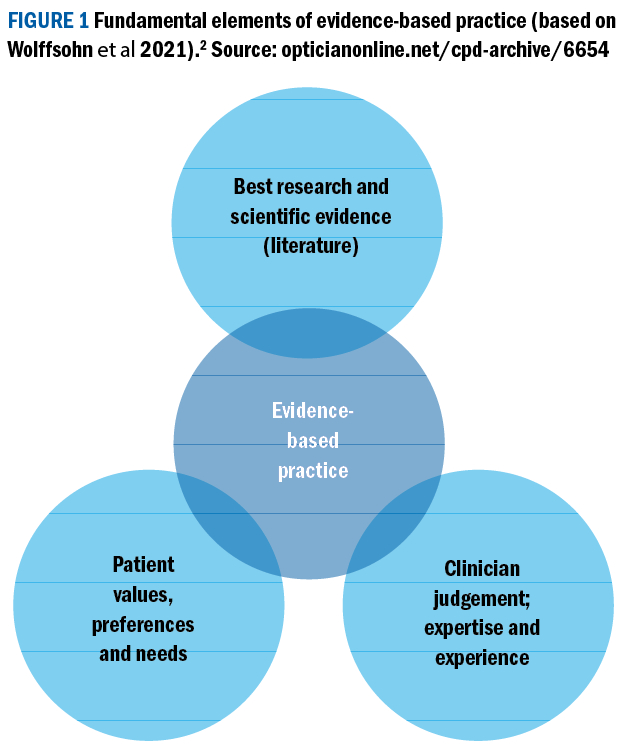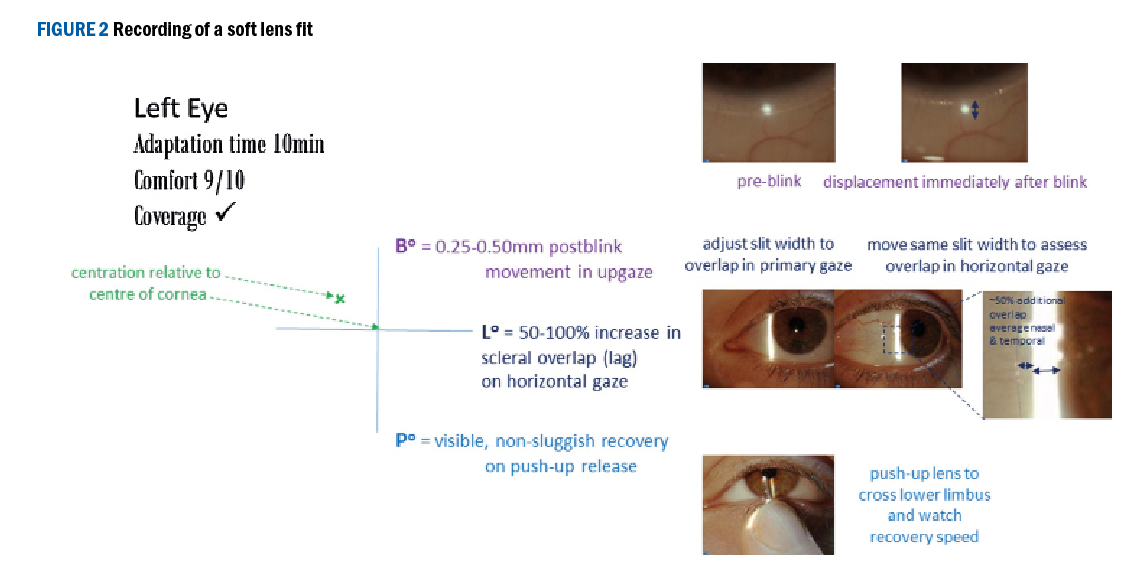
Why do we do what we do? That was the central question to part 10 of a series of articles summarising key findings from the BCLA CLEAR reports and the source material for this interactive exercise.1 The article (Optician 29/9/23) discussed the findings of the BCLA CLEAR report on evidence-based contact lens practice; specifically, the elements relating to contact lens fitting.2
A summary of the contact lens fitting routine was provided with reference to supporting evidence and, where indicated, gaps in the knowledge were also highlighted. Below we introduce an interactive CPD activity related to the topic, to be completed after reviewing the associated article.
Case 1
A 30-year-old patient attends for a new contact lens fitting. She works in an office-based role, with around five to six hours of daily VDU use at work plus several hours spent looking at a smartphone. Refractive error is R -2.00 DS L -1.75/-0.75x95
She would like soft daily disposable contact lenses for infrequent wear, approximately once every week. She has previously worn contact lenses, but tells you she suspended wear for three years, but does not explain why.
You begin to run through the contact lens fitting process and find the slit lamp examination to be unremarkable. You start taking baseline measurements for lens selection, but the patient questions asks whether it is necessary to undergo so many different tests.
During your discussions with a colleague you may consider:
- Based on the information available, when would you expect to recommend a daily, two-weekly or monthly, or an alternative replacement frequency lens? Please provide your reasons for your choice and any reasons for not choosing alternatives.
- When calculating a first-choice lens, in this particular case, would you take the back vertex distance into account? At what point must you do so?
- Would you consider fitting this patient with a toric contact lens? Provide reasons for your decision.
- Which baseline measurements do you feel are necessary for soft contact lens fitting and why?

Case 2
You fit a 41-year-old patient with soft toric single vision lenses. VA with habitual spectacle correction was 6/6 for both eyes and the patient could see N5 at 45cm. Following application of the trial lenses, the patient complains of blur, yet you still record 6/6 with both eyes although she struggles to see N5 at near.
- How would you ascertain the cause of the patient’s complaints?
- You proceed to checking the lens fit, what specific observations do you routinely make and how would you record these?
- Are there any additional slit lamp observations you would make, other than those relating to lens movement?
- What are your management options?

- Dr Manbir Nagra is an optometrist, educator, and researcher. She works as an independent consultant within the optical sector and is clinical editor (optometry) for Optician.
- Neil Retallic is an optometrist with experience of working with in practice, education, industry, and head office roles. He currently works for Specsavers and the College of Optometrists and is the immediate past president of the British Contact Lens Association.
- Listen to the BCLA CLEAR Evidence-based contact lens practice podcast: https://anchor.fm/bcla/episodes/BCLA-CLEAR-Podcast-1-Evidence-based-practice-e179tp5
References
- https://www.opticianonline.net/cpd-archive/6654
- Wolffsohn, JS, Dumbleton, K, Huntjens, B, Kandel, H, Koh, S, Kunnen, CME, Nagra, M, Pult, H, Sulley, A.L, Vianya-Estopa, M, et al. CLEAR - Evidence-based contact lens practice. Contact lens & anterior eye:the journal of the British Contact Lens Association 2021, 44, 368-397, doi:10.1016/j.clae.2021.02.008.
Interactive CPD instructions
In order to log one provider-led interactive CPD point to your MyCPD account, this is what you need to do:
- Make sure you have read the article: BCLA CLEAR 10 Evidence-based contact lens practice Part 1 – Contact lens fitting, by Dr Manbir Nagra and Neil Retallic.
- Arrange a time to undertake a discussion on the subject with a similarly qualified registrant; another optometrist or contact lens optician.
- Read the case scenario and questions and use them as the basis for the discussion with your colleague. Note, the discussion needs to address each of the questions outlined above and must be for longer than 10 minutes.
- When finished, you then need to send an email to opticiancpd@markallengroup.com as follows:
- Subject box should state ‘BCLA CLEAR 10 EBP PART 1’
- Please state your name and GOC number.
- Please state the name and GOC number of the person you discussed the matter with.
- Please confirm you had read the source material.
- Please include a summary of your discussion, explaining your views and thoughts on each of the discussion questions
- Each submission will be read individually and, where needed, feedback will be given directly. Where the submission meets a required standard, you will receive an email confirming this, which you can then use as evidence of completion allowing you to log one distance learning interactive CPD point.
- A summary of the responses and discussions will appear in a future issue of Optician with comment from the authors.
